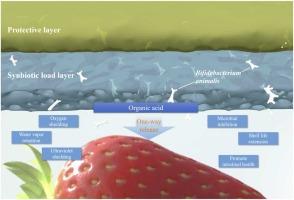Bilayer Bifidobacterium animalis/xylooligosaccharides film enables long-term maintenance of probiotics activity and prolongs strawberry shelf life
IF 10.6
1区 农林科学
Q1 FOOD SCIENCE & TECHNOLOGY
引用次数: 0
Abstract
To address the low survival of fragile probiotics such as Bifidobacterium animalis (B. animalis) and the safety concerns of chemical antimicrobials in fruit preservation, we developed a bilayer synbiotic film for one-way release of probiotic metabolites. The film contains an inner sodium alginate (SA) matrix co-encapsulating B. animalis and xylo-oligosaccharides to sustain metabolic activity, and an outer gelatin (GE) layer that acts as a physical barrier against external stressors. Compared with monolayer films, the bilayer system (SA/GE–B/X) reduced oxygen permeability by 39.66 % and water vapour permeability by 12 %. It reduced visible light transmittance and completely blocked UVA, with increased maximum degradation temperature. Probiotic viability in SA/GE–B/X reached 9.68 log CFU g⁻¹ after drying and remained at 7.36 log CFU g⁻¹ after 30 days at 25 ℃, markedly higher than SA–B/X (4.82 log CFU g⁻¹). The SA/GE–B/X film extended strawberry shelf life to 14 days at 4 ℃, compared with 6 days for controls. It reduced weight loss at 25 ℃ (29.68 % vs. 35.12 % for the monolayer) and suppressed mould growth (3.55 vs. 5.71 log CFU g⁻¹). Under simulated digestion, the GE layer reacted with gastric fluid to form a protective gel, increasing probiotic survival 1.69-fold relative to SA–B/X. This synbiotic bilayer combines physical preservation, microbial regulation, and gut-health promotion, and offers a practical route for applying anaerobic probiotics in open packaging and eco-friendly, microbe-driven preservation.

双层动物双歧杆菌/低聚木糖膜能长期维持益生菌活性,延长草莓的保质期
针对动物双歧杆菌(Bifidobacterium animalis, B. animalis)等脆弱益生菌存活率低的问题,以及化学抗菌剂在水果保鲜中的安全性问题,我们开发了一种用于益生菌代谢产物单向释放的双层合成膜。膜内含有海藻酸钠(SA)基质,共包封动物双球菌和低聚木糖以维持代谢活性,外膜含有明胶(GE)层,作为抵抗外部应激源的物理屏障。与单层膜相比,双层膜(SA/ GE-B /X)的氧透性降低了39.66 %,水蒸气透性降低了12 %。它降低了可见光透过率,完全阻挡了UVA,提高了最高降解温度。SA/ GE-B /X的益生菌活力在干燥后达到9.68 log CFU g⁻¹ ,在25℃下30天后保持在7.36 log CFU g⁻¹ ,明显高于SA - b /X(4.82 log CFU g⁻¹)。SA/ GE-B /X薄膜将草莓在4℃下的保质期延长至14天,而对照组为6天。它减少了25℃时的重量损失(29.68 %对35.12 %的单层)和抑制霉菌生长(3.55对5.71 log CFU g⁻¹)。在模拟消化条件下,GE层与胃液反应形成保护凝胶,益生菌存活率比SA-B /X提高1.69倍。这种合成双分子层结合了物理保存、微生物调节和肠道健康促进,并为在开放式包装和生态友好、微生物驱动的保存中应用厌氧益生菌提供了一条实用的途径。
本文章由计算机程序翻译,如有差异,请以英文原文为准。
求助全文
约1分钟内获得全文
求助全文
来源期刊

Food Packaging and Shelf Life
Agricultural and Biological Sciences-Food Science
CiteScore
14.00
自引率
8.80%
发文量
214
审稿时长
70 days
期刊介绍:
Food packaging is crucial for preserving food integrity throughout the distribution chain. It safeguards against contamination by physical, chemical, and biological agents, ensuring the safety and quality of processed foods. The evolution of novel food packaging, including modified atmosphere and active packaging, has extended shelf life, enhancing convenience for consumers. Shelf life, the duration a perishable item remains suitable for sale, use, or consumption, is intricately linked with food packaging, emphasizing its role in maintaining product quality and safety.
 求助内容:
求助内容: 应助结果提醒方式:
应助结果提醒方式:


